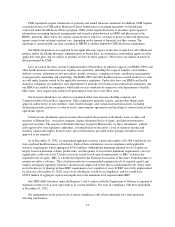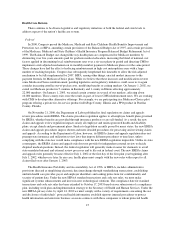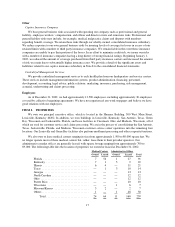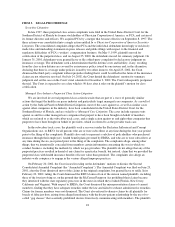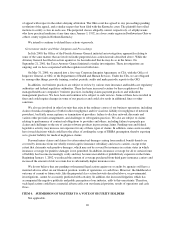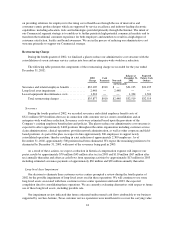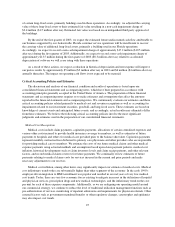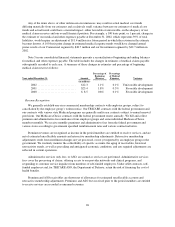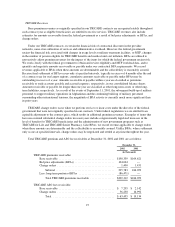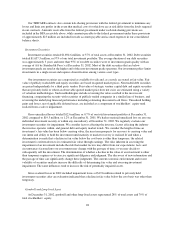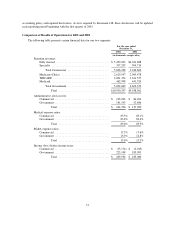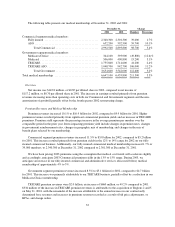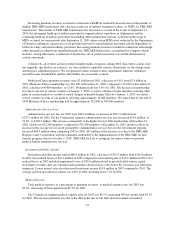Humana 2002 Annual Report Download - page 29
Download and view the complete annual report
Please find page 29 of the 2002 Humana annual report below. You can navigate through the pages in the report by either clicking on the pages listed below, or by using the keyword search tool below to find specific information within the annual report.ITEM 7. MANAGEMENT’S DISCUSSION AND ANALYSIS OF FINANCIAL CONDITION AND
RESULTS OF OPERATIONS
The consolidated financial statements of Humana Inc. in this document present the Company’s financial
position, results of operations and cash flows, and should be read in conjunction with the following discussion
and analysis. References to “we,” “us,” “our,” “Company,” and “Humana” mean Humana Inc. and its
subsidiaries. This discussion includes forward-looking statements within the meaning of the Private Securities
Litigation Reform Act of 1995. When used in this filing and in future filings with the Securities and Exchange
Commission, in our press releases, investor presentations, and in oral statements made by or with the approval
of one of our executive officers, the words or phrases like “expects,” “anticipates,” “intends,” “likely will
result,” “estimates,” “projects” or variations of such words and similar expressions are intended to identify
such forward–looking statements. These forward–looking statements are not guarantees of future performance
and are subject to risks, uncertainties and assumptions, including, among other things, information set forth in
the “Cautionary Statements” section of this document. In light of these risks, uncertainties and assumptions, the
forward–looking events discussed in this document might not occur. There may also be other risks that we are
unable to predict at this time. Any of these risks and uncertainties may cause actual results to differ materially
from the results discussed in the forward–looking statements.
Introduction
Headquartered in Louisville, Kentucky, Humana Inc. is one of the nation’s largest publicly traded health
benefits companies, based on our 2002 revenues of $11.3 billion. We offer coordinated health insurance coverage
and related services through a variety of traditional and Internet-based plans for employer groups, government-
sponsored programs, and individuals. As of December 31, 2002, we had approximately 6.6 million members in
our medical insurance programs, as well as approximately 1.6 million members in our specialty products
programs. We have approximately 425,000 contracts with physicians, hospitals, dentists and other providers to
provide health care to our members. In 2002, approximately 70% of our premiums and administrative services
fees resulted from members located in Florida, Illinois, Texas, Kentucky, and Ohio. We derived approximately
44% of our premiums and administrative services fees from contracts with the federal government in 2002.
Under two federal government contracts with the Department of Defense, we provide health insurance coverage
to TRICARE members, accounting for approximately 19% of our total premiums and administrative services
fees in 2002. Under one federal government contract with the Centers for Medicare and Medicaid Services, or
CMS, we provide health insurance coverage to approximately 228,400 Medicare+Choice members in Florida,
accounting for approximately 16% of our total premiums and administrative services fees in 2002.
We manage our business with two segments: Commercial and Government. The Commercial segment
consists of members enrolled in products marketed to employer groups and individuals, and includes three
lines of business: fully insured medical, administrative services only, or ASO, and specialty. The Government
segment consists of members enrolled in government-sponsored programs, and includes three lines of business:
Medicare+Choice, Medicaid, and TRICARE. We identified our segments in accordance with the aggregation
provisions of Statement of Financial Accounting Standards No. 131, Disclosures About Segments of an
Enterprise and Related Information which is consistent with information used by our Chief Executive Officer in
managing our business. The segment information aggregates products with similar economic characteristics.
These characteristics include the nature of customer groups and pricing, benefits and underwriting requirements.
The results of each segment are measured by income before income taxes. We allocate all selling, general
and administrative expenses, investment and other income, interest expense, and goodwill, but no other assets or
liabilities, to our segments. Members served by our two segments generally utilize the same medical provider
networks, enabling us to obtain more favorable contract terms with providers. Our segments also share overhead
costs and assets. As a result, the profitability of each segment is interdependent.
Our business strategy centers on increasing Commercial segment profitability while maintaining our
existing strength in the Government segment. Our strategy to increase Commercial segment profitability focuses
23



